Willamette University
“Drinking wine or intoxicating liquors, smoking, card playing, swearing, immorality of any kind, quarreling, rude and unkind treatment of fellow pupils, the throwing of stones, disobedience, indolence, and any other acts or behavior calculated to injure the reputation and peace of the University or the moral habits of the students, are entirely prohibited.”
The beginning
In 1834, Jason Lee and his party of missionaries established a Mission north of Salem to work with the local Indians. They also set up a school which became known as the Indian Manual Labor School to teach the Indian children. Within four years of the Mission’s founding, Lee asked for additional help, and in response to his request, the “Great Reinforcement” of 1839 brought 53 more people from New York to work at the Mission. They arrived on the ship Lausanne and entered into the community and missionary life of the area.
On January 17, 1842, the missionary community gathered at the home of Jason Lee to consider establishing a school for their own children and the children of other settlers. On February 1, a board of trustees was appointed, a constitution and bylaws were adopted, and the Oregon Institute was established. This event marked the founding of Willamette University. The board of trustees for the new school was comprised of the Jason Lee, David Leslie, Gustavus Hines, Josiah Parrish, Lewis Judson, George Abernathy, Alanson Beers, Hamilton Campbell, and Dr. Ira Babcock.
From these modest beginnings, Willamette University became the centerpiece of Salem. The University anchored Salem’s growth and development, and provided an educational, religious, and cultural base that drew settlers to the area.
The Oregon Institute
In 1841, the school building that was the Indian Manual Labor School was moved from the mission site to the grounds of the Oregon Institute (Willamette University). The three story frame building was the most imposing structure of its kind on the Pacific Coast at the time. By 1844, instruction was stopped at the Indian Manual Labor School. The Oregon Institute bought the building, and on August 13, 1844, the Oregon Institute officially opened in the former Indian Manual Labor School building. It became the Institute’s boarding school for the children of the missionaries and settlers.
Mrs. Chloe Clarke Willson, the first teacher at the Institute, taught 5 students the first year. The first meeting of the Oregon-California Conference was held at the Institute in 1849. At the conference, the Institute was officially recognized as a Methodist school. The following year, the Reverend Francis S. Hoyt became the president of the Oregon Institute and was later the first president of Willamette University.
During these early years, the trustees enacted some rules of conduct for Institute students. They included, “Drinking wine or intoxicating liquors, smoking, card playing, swearing, immorality of any kind, quarreling, rude and unkind treatment of fellow pupils, the throwing of stones, disobedience, indolence, and any other acts or behavior calculated to injure the reputation and peace of the University or the moral habits of the students, are entirely prohibited.”
Willamette University gets its name
In 1853, the Oregon Territorial Legislature, which held their sessions in the basement of the University building, granted a charter to “Wallamet University”. “Wallamet University” eventually became “Willamette University” when the current spelling of Willamette was first used in the University catalog of 1870-71. The first graduate of Willamette University was Miss Emily J. York. She received the degree of Mistress of English Literature in 1859.
Waller Hall
In 1861, the trustees agreed to let a mill stream be dug across the campus. This was for the use of the nearby woolen mill. In 1864 a new college building was started through the efforts of Reverend Alvan Waller. The bricks for the building were fired on the University grounds and were made from clay excavated for the foundation. University Hall, as the new building was known, was an imposing five-story building. It was constructed in the shape of a Greek cross that became a commanding landmark in the sparsely settled Oregon country. In 1912, University Hall was renamed Waller Hall after Reverend Alvan Waller. In 1919 the interior of Waller Hall was destroyed by fire but was rebuilt the next year.
Reverend Joseph Wythe was elected President of Willamette University in 1865. He was a highly accomplished administrator and educator who taught mental and moral science in the College Department, hygiene and microscopy in the Medical Department, and biblical languages and literature in the Theology Department. His many virtues did not outweigh his habit of smoking in public, and the trustees asked Wythe to leave the University in 1867.
From 1867 to 1890 Willamette University experienced many changes along with steady growth. The Medical College, the first professional school in the Northwest, was established at Willamette in 1867 and started offering classes that year. In 1872, the original Oregon Institute building burned down. That same year, the University grew to include an elementary school, a Commercial Department open to both men and women, and a Medical Department. 1872 also saw the Music Department grant its own degrees. The annual enrollment at Willamette during the 1870’s averaged about 280 students, out of that number, 81 were college students.
Lausanne Hall
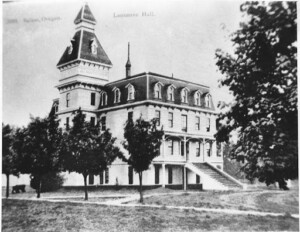
The first Lausanne Hall, Willamette University. Campus. Originally Home of Chloe Wilson, C 1880. Was modified and add to by W.U., WHC Collections 2004.010.0628
The Willamette Collegian began publishing in 1875, and in 1880, the Musical Institute was established in the original Lausanne Hall. Lausanne Hall was the former home of Mrs. Chloe Clarke Willson, the first teacher at the Oregon Institute. The Women’s College was also established in Lausanne Hall in 1880. At its inception, it was stated that the Women’s College was ,“a modification, but in no sense a surrender of co-education.” 1880 also saw the Medical Department leave University Hall and establish itself in Portland.
By 1883 the College of Law was established on campus, and in 1888 the University’s wooden fences were all pulled down because they were no longer needed to protect the campus from the nearby grazing cows.
In 1891 many changes affected the campus. The new chancellor of Willamette, Charles Stratton, class of ‘69, left the University in January. He became president of the new, rival Methodist university in Portland. President Van Scoy soon followed Charles Stratton to the new university in June, 1891. Van Scoy became the rival school’s new dean. Many other students and faculty, including the entire College of Theology, also joined them in Portland.
The College of Medicine returned to Salem in 1895, after a crisis over clinical privileges at its Portland hospital. Medical classes met in University Hall and other rooms around town. In the same year, Willamette saw both a new gymnasium and a paid coach on campus thanks to the generosity of a $250 University Fund with “Subscriptions from many individuals.” The school colors, cardinal red and gold were chosen. In 1896 the College of Pharmacy closed and by 1899, Willamette University and its failed rival, Portland University reunited in Salem. That fall, they came together under the “time-honored name” of Willamette University.
Eaton Hall
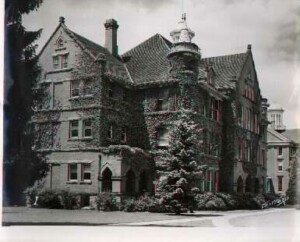
Gifford. Eaton Hall on Willamette University Campus. View toward S.W. Waller Hall at right. Salem Public Library MJON 0198, WHC Collections 1998.010.0022
The first Wallulah was published in 1903, and in 1906 the Medical College moved into a new building on the northwest corner of the campus. In succeeding years the building would house the Willamette Academy, the Science Department, the College of Music and the Art Department. Through a gift from the Honorable A. E. Eaton, Eaton Hall was completed in 1909. The Freshman Glee began this year when they challenged other classes to a song competition, and the Kimball School of Theology was established.
By 1913, the College of Medicine closed at Willamette and merged with the University of Oregon College of Medicine. Six years later, in 1916, after 72 years, the last class of the Oregon Institute (Willamette Academy) graduated. The Institute was no longer needed because public high schools had been established in Salem. A fire in 1921 destroyed the original wooden gymnasium, but in 1923, a new, large brick gymnasium was built to replace the old building. In 1927, Willamette received accreditation from the Association of American Universities, and in 1930, the Kimball School of Theology closed its doors.
Dancing gets a break
In 1935, dancing was permitted on a limited basis, and by 1938-39, the University was allowing student dances to be held on campus. The 1936 class completed a four-year sweep of top Glee honors and was the first Willamette class to do so. In 1938, the new library building was completed and University House was moved to campus where it served as the president’s home until 1955. In 1939, the College of Law moved into its new home, the old Salem post office, now called Gatke Hall.
In 1941, Willamette’s football team was in Hawaii when Pearl Harbor was bombed. They had played the University of Hawaii just the day before the attack. When the team returned home, they helped out on a ship that was bringing the wounded to the mainland for hospitalization. The same year, Reverend Carl Knopf was elected president of Willamette. Later the following spring, he resigned in a public relations crisis over his alleged conduct at a selective service registration.
“Fusser’s Guide”
Insight into Willamette’s early social scene can be found in “Fusser’s Guide”. It is a unique campus directory that has a completely novel history all its own. The originality of the Guide reflects Willamette’s unique place in the history of Salem; “While most colleges and universities publish campus phone directories, few have as unusual name as Willamette’s.
During the 1920’s, men used to keep the names and addresses of women in little black books. These names were exchanged within a small group of men known as “fussers” because of their dress and fastidious tastes. Eventually one of the fussers, Jason L. Geidenburg, compiled and published a comprehensive book of names and addresses. Willamette University’s first student directory was called Fusser’s Guide in honor of these resourceful men. The “Fusser’s Guide” has changed drastically since its inception. It no longer publishes a social calendar or athletic schedules. The directory isn’t separated into men’s and women’s sections (or “Bearcat Belles” and “Bearcat Beaus” as in the 1949-50 and 1950-51 editions or as “The Lovelies of W. U.” and “Handsome Lads of W. U. “ in the 1948-49 edition). Some editions in the past incorporated the student handbook, and several weren’t called the Fusser’s Guide at all.”
Star Trees and the 100th Anniversary
In 1942, the Willamette Centennial was celebrated, commemorating the 100th anniversary of the founding of the University. President Knopf planted five giant sequoia trees, the , as part of the centennial celebration. These trees would become the “Temple of the Centuries”, or “Star Trees” as they are known today. A year later, in 1943, a College Navy Training Program (V-12) was established on campus. It was housed in Lausanne Hall and trained medical personnel and deck officers from July 1943 through November 1945. A heavy program of physical conditioning included an obstacle course that was reputed to be one of the toughest in the West.
The 1940’s, 50’s and 60’s saw the establishment of more national sororities and fraternities on campus. In 1944, chapters of Alpha Chi Omega and Pi Beta Phi sororities were organized, and in 1945-46 chapters of Delta Gamma and Chi Omega sororities also joined their sister sororities on campus. 1947 brought chapters of Beta Theta Pi, Phi Delta Theta and Sigma Chi fraternities to the University, and the local Phi Alpha fraternity established a chapter with Sigma Alpha Epsilon. In 1955, a chapter of the national senior men’s honorary, Omicron Delta Kappa was established on campus. In 1957, the Mortar Board, a senior women’s honorary, was brought to Willamette, and in 1960-61, chapters of Delta Tau Delta and Kappa Sigma fraternities were established.
The campus grows
In 1950, McCulloch Stadium was built on a 10 acre tract of land on Bush’s Pasture that had been acquired in 1946. In 1955, three new buildings, the Charles P. and Fannie Kay Bishop Memorial Health Center, the G. Herbert Smith Auditorium, and the Doney Residence Hall for women were all added to the campus grounds. 1960-61 saw the addition of the Lucy Anna Lee and Emily J. York Residence Halls for women, and the James T. Mathews and Lewis F. Belknap Residence Halls for men. In 1967, two more new buildings, the Truman Wesley Collins Legal Center, and the William S. Walton Hall were opened, and in 1970, the George Putnam University Center was dedicated.
Willamette University has always been a leader among small colleges and universities. Through the years Willamette has been the recipient of many awards, honors, and accolades that have established her reputation as an outstanding institution of higher learning. Willamette’s College of Law was admitted as a member of the Association of American Law Schools in 1946. In 1948, Willamette was rated among the outstanding small colleges in the United States by Good Housekeeping. The same year, the school paper, the Collegian received the prestigious Pace Makers award after an unprecedented sixteenth consecutive All-American designation. In 1949, Lowell Thomas originated a national broadcast on CBS from Waller Hall. The following year, the Mutual Broadcasting System featured the Willamette A Capella Choir on a coast- to- coast broadcast, and the “Semester in Washington” program began in the College of Liberal Arts.
More student achievements
In 1955, for the fourth time in five years, the Willamette forensic squad was invited to participate in the National Invitational Debate Tournament. 1956 saw the establishment of the Atkinson Lecture Series, and in 1958 The United States Steel Corporation, in cooperation with the American Alumni Council, selected Willamette as national award winner for the best record of improved alumni support among coeducational colleges. In 1959, the College of Law’s Moot Court team won the national championship. 1962 saw a team from Willamette appear on the General Electric “College Bowl”, and in 1965 Willamette entered into a sister college relationship with the International College of Commerce and Economics, now known as Tokyo International University.
Mark O. Hatfield Library
In 1980, an $18 million fund raising drive was begun. Several major academic buildings were renovated, campus grounds were improved and the Mark O. Hatfield Library was built thanks to the money that was raised.
In 1983 Willamette was selected by a U. S. News & World Report poll of college and university presidents as the best small comprehensive university in the West. By 1985, a sister-university relationship was entered into with Xiamen University in Fujian Province of the People’s Republic of China, and with Kookmin University in Seoul, Korea. Another new sister university agreement was signed in 1987 with Simferopol State University in what is now the Ukraine. The exchange program began in 1989. In 1990, for the fourth consecutive year, Willamette enrolled more National Merit Scholars in its entering undergraduate class than any other private school in the Northwest.
The first three days in February, 1991, saw 24 birthday parties held across the country and overseas to celebrate the 149th anniversary of the founding of Willamette University.
Sesquicentennial Founders’ Day Weekend
The next year, 1992, a special Sesquicentennial Founders’ Day Weekend was held. It was filled with special events that included the issuing of a commemorative U.S. postal card featuring Waller Hall, and the dedication Mark Sponenburgh’s bronze sculpture, Town and Gown. The refurbished Victory Bell was rung 150 times to commemorate the anniversary. Later in the year, on September 10, the Truman Wesley Collins Legal Center was re-dedicated. United States Supreme Court Justice, Sandra Day O’Connor was the keynote speaker.
Atkinson Graduate School of Management
In 1995, The Atkinson Graduate School of Management earned accreditation from both the American Association of Schools of Business and the National Association of Schools of Public Affairs and Administration. Its integrated Master of Management is the first and only program with this dual accreditation. The Kilkenny Family Lecture Hall and Technology Lab were dedicated October 12th at the Atkinson School. More innovation was initiated at the Atkinson Graduate School of Management in 1999. A new core curriculum, PaCE (Private, Public and Community Enterprise) was started which involved students in creating business enterprises that would give their profits and volunteer hours to a Salem area community service organization.
In 2000, Willamette was named a 2000 Truman Foundation Honor Institution for its exemplary participation in the Truman Scholarship program. Thus far, only 38 colleges and universities have been selected for this honor.
Willamette Sports History
Throughout Willamette’s history, sports have been an important part of University life. In 1963, the Bearcat golf team, led by All-American, Bob Woodle, placed seventh at the National Association of Intercollegiate Athletics Tournament, and in 1968 Willamette’s football team, coached by Ted Ogdahl and led by All-American Calvin Lee, was ranked third in the nation by NAIA after finishing an undefeated regular season. 1987 the men’s track team won its seventh straight, and ninth out of tenth, Northwest Conference championship. The track team was coached by Charles Bowles. In 1991, Willamette inaugurated its Athletic Hall of Fame. It inducted 16 people the first year. In 1993, the men’s basketball team won the NAIA Division 2 National Championship, and Coach Gordie James was named the NAIA Division 2 Coach of the Year. The Bearcat football team once again had a great season in 1997, when they advanced to the NAIA national championships, finally losing 14-7 to Findlay (Ohio).
The center of many of Willamette’s sporting triumphs, McCulloch Stadium, was re-dedicated in 1993 after a major renovation, made possible by a gift from Bill Long, ‘59. At the ceremony, the new field was dedicated as Ted Ogdahl Field, honoring the former Willamette coach. The stadium’s locker room was dedicated to Jeff Knox ‘69, who played offensive guard for Willamette from 1965 to 1968. Knox died of cancer in 1972. In 1994, Willamette’s athletic program won the Northwest Conference All-Sports award for the 1993-94 school year. It marked the first time the Bearcats had won the trophy since it was started in 1985-86.
In 1997, Elizabeth Heaston, ‘99, made history, when she became the first woman to play in a collegiate football game. She kicked two extra points in a 27-0 win over Linfield College. In 1999, for the first time in the University’s history, national track and field championships were won by a Willamette woman and man. Beth Fitzgerald won the 800 meters, and Jimmy Watts took the decathlon. They are both graduates of the class of ‘99, and in 2000, alumnus Andrew Hermann ‘93, set an American race-walking record on his way to a berth in the 2000 Olympic Games.
In December, 1997, the first lighting of the “Star Trees”, planted in 1942 as part of Willamette’s centennial celebration, became a new campus tradition. The annual tree lighting event symbolizes the partnership of the University with the community of Salem.
Through the years Willamette has been lead by many fine presidents. In 1997, Jerry E. Hudson became president emeritus. He retired in July, 1997 after serving 17 years as president of Willamette University. Bryan Johnston followed Jerry Hudson, serving as interim president for the 1997-98 academic year. In 1999, President M. Lee Pelton was inaugurated on February 19th, capping a week of academic and celebratory events. He became Willamette’s 22nd president.
“First University in the West”
In 2000, Willamette introduced a new logo and slogan, “First University in the West”. It is most appropriate that Willamette University looks to her past to carry her forward into a new century of growth and continued excellence.
Compiled and written by Susan Gibby
Bibliography:
Location of Research/City: Willamette University, Salem
Faxed information on the history of Willamette August 2000
Owning Agency: Willamette University
This article originally appeared on the original Salem Online History site and has not been updated since 2006.



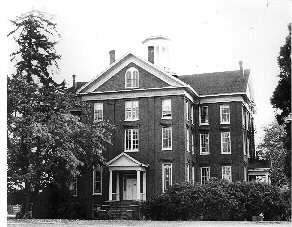
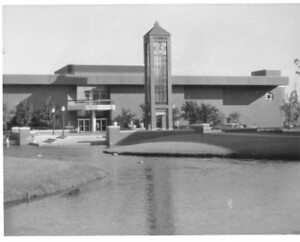
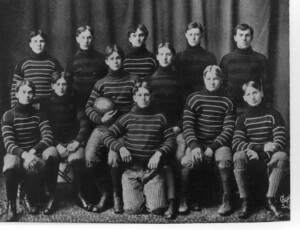




Leave A Comment